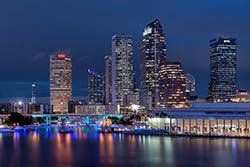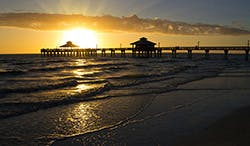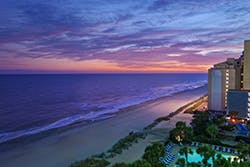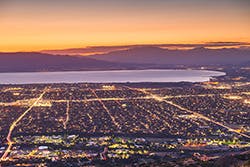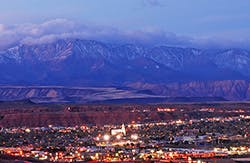It’s not easy to pick the 10 local market areas with the most potential for electrical product sales growth out of the 300-plus Metropolitan Statistical Areas (MSAs) in the United States, because each local market has a unique economic profile and economic drivers to consider. For instance, the fast-growing MSAs along Florida’s Gulf Coast rely on double-digit population growth to fuel demand for new vacation homes, senior housing and single-family homes for new residents from colder climates. On top of this region's normal growth prospects, the catastrophic damage from Hurricane Ian is creating demand for storm repair supplies and, over the next few years, millions of dollars in electrical sales for new construction and renovation work.
In industrially oriented markets like the Elkhart-Goshen, IN MSA, you must watch industrial employment data from the U.S. Census Bureau and look for news about plant expansions in that market’s dominant recreational vehicle manufacturing industry. Ditto for the Detroit-Warren-Dearborn, MI MSA and many other Michigan markets whose economic fortunes are tied to the amount of industrial business flowing through Ford or General Motors auto plants.
It’s also hard to compare the nation’s largest metropolitan areas and their billions of dollars in sales potential with much smaller metros that may be growing at a double-digit growth rate but represent a fraction of the larger markets’ potential electrical sales. According to Electrical Marketing’s (EM) electrical sales potential data, 27 MSAs have at least $1 billion in electrical sales potential and 18 markets could generate annual sales of between $500 million and $1 billion. If you need market data on other local markets or all 50 states, it’s available as part of a $99 EM annual subscription.
The fastest-growing market areas shine when you measure them against state or national growth rates in electrical sales potential, electrical contractor or industrial employment, building permits or population growth. EW’s editors first sorted all MSAs by their growth as measured by each of these indicators, and then pared down each list to the MSAs that were growing by at least double their state’s rate on a year-over-year and five-year basis.
Click through the 10 slides in the gallery above and capsule summaries below for brief analysis and data for 10 local markets that emerged from this gauntlet of economic indicators with superior growth rates. We picked out the economic indicators that stood out most in each market. In most MSAs, multi-family construction is currently more notable than single-family permits. More in-depth local data is available to EM subscribers.
Houston, the fourth largest electrical market in the United States, is one of the few markets in the United States where its electrical sales potential of $3.4 billion through 2Q 2022 as estimated by Electrical Marketing, is growing at double the pace of the United States. It logged a quarter-to-quarter QtQ gain of +7% and a year-over-year (YOY) gain of +9.3%.
While a report by the Greater Houston Partnership says oil industry employment has been slow to recover to pre-pandemic levels, overall industrial employment for the Houston-The Woodlands-Sugar Land MSA through July is up +4% YOY with 8,586 more employees on the payroll than in July 2021. The most recent electrical contractor employment data is also solid with a +7.4% QtQ increase to an estimated 30,000-plus electrical contractor employees.
According to an article in the Houston Chronicle, some of the most interesting projects underway or on the drawing boards are Megatel Homes $2-billion lagoon in a 1,000-home development called Saint Trope; the $1.8-billion first phase of the Texas Medical Center’s TMC3 project; and the $2.5-billion East River mixed-use development.
AUSTIN, TX
Although the Austin metro’s total estimated electrical sales potential top $1 billion, its QtQ (+1.3%) and year-over-year (+0.5%) growth metrics are pretty pedestrian. Long one of the hottest housing markets in the country, building permit activity has also slowed down through mid-year.
However, the market’s growth metrics are tough to beat in many other areas. It remains a popular relocation destination, with 117 new residents moving in each day and 2021 net migration of 42,541 new residents. It also added 292,489 residents in the past five years — enough people to fill the football stadium for the city’s beloved University of Texas Longhorns three times.
Construction sites are busy downtown, and in the first half of 2022 at least five multi-family, mixed-use or office towers valued at $100 million or more broke ground. An even bigger project is the 500,000-sq-ft expansion of Tesla’s 4-million-sq-ft Gigafactory that according to a post at www.electrek.com would include two new assembly lines.
As the largest metropolitan area on Florida’s Southwest Gulf Coast, the Tampa-St. Petersburg-Clearwater, is seeing growth on a larger scale than the mid-sized and small MSAs down the coast — Northport-Sarasota-Bradenton, Cape Coral-Ft. Myers and Naples-Immokalee-Marco Island. It’s adding new residents in a big way, with 258,488 new residents from 2015 to 2020 and 125 new residents per day in 2021. Tampa is in the midst of a multi-billion dollar building surge downtown, with the $3-billion Water St. revitalization project underway; the ongoing $500-million Midtown Tampa redevelopment; the $600-million Westshore Marina District development; and the Gas Worx mixed-use project in the Ybor City neighborhood.
Electrically speaking, this MSA is a member of the billion-dollar club, with an estimated $1.27 billion in total estimated sales potential through 2Q 2022. Recent growth has been average, with a QtQ increase of +1.4% and a +2.4% YOY increase. Longer-term, electrical contractor employment growth has been impressive with a 2,171-employee gain (+22%) from 2015 to 2020.
Residents in this MSA were bracing themselves for a direct hit from Hurricane Ian, which made landfall approximately 90 miles south, near Fort Myers, FL.
About 76 miles south of Sarasota on Interstate 75, the Cape Coral-Fort Myers MSA attracted more than 26,000 new residents in 2021 according to Census Bureau net migration data, most likely for the very same reasons snowbirds are flocking to other beach areas along the Gulf Coast — gentle waves and soft sand; great fishing; MLB spring training and killer seafood. With more than 90,000 new residents moving in over the past five years, this MSA continues to grow fast. Through July, multi-family building permits were up 931 over 2021’s year-to-date pace to 1,725 permits. Single-family permits were up just +1.7% over 2021 at 6,320 permits, but that’s an impressive number for a mid-sized MSA.
The MSA’s total estimated electrical sales potential was up +2.3% YOY to $456.2 million and was pacing a bit faster with a +3.1% clip QtQ at mid-year.
Damage from Hurricane Ian will be a factor in this market for years to come.
This metropolitan area with $395.7 million in estimated total electrical sales potential has grown steadily over the past decade with the same formula that works for many of Florida’s MSAs — double-digit population growth, steady housing construction and plenty of sunshine to keep folks moving down to some of the best beaches in the country.
As in the other MSAs along Florida’s Gulf Coast, industrial business is pretty light in the Sarasota electrical market at an estimated 9% of total sales, but the metro’s electrical contractors are busy with all of the new home construction, particularly in the multi-family market. Permits for building with 5 units or more were up +41.3% YOY through July to 2,301 permits. The single-family market hasn’t seen the same increase so far this year, but they still topped 7,600 permits through July according to the most recent data.
The southern part of this MSAs was near the center of Hurricane Ian's fury.
The steady and sometimes spectacular growth of the Myrtle Beach area and its 60 miles of beaches called the “Grand Strand” along South Carolina’s northern coast has a pretty “beachy” growth strategy — mix plenty of sun, golf, warm weather and a comparatively favorable cost of living to provide an escape from cold Northern or Midwestern winters. The area has gained 82,816 new residents over the past five years and in 2021 new South Carolinians were moving in at the rate of 60 new residents per day.
As an electrical market, the Myrtle Beach-Conway-North Myrtle Beach MSA is one of the smallest of EW’s local market picks with total estimated sales potential of $149.9 million, but the area’s steady flow of retirees looking for the good life and folks looking for a beach house or condo supports an active housing market in most years. Single-family permits saw a nice bump through July with a 1,139-permit increase (+19.3%) to 7,035 permits year-to-date.
Not all of the fastest-growing markets are major metropolitan areas. The Provo-Orem MSA is a good example of a relatively small market electrical market with an estimated sales potential of $455 million and a population of less than a million that showing some impressive growth in electrical sales. Electrical Marketing estimates that through 2Q 2022, its electrical sales potential increased +11.8% QtQ and +14.1% YOY.
Nestled in the foothills of the Wasatch Mountains about 45 miles south of Salt Lake City, the area’s population has been growing at a double-digit rate over the past five years. It’s adding 38 new residents per day and has added over 79,000 new residents since 2016. Home to Brigham Young University, the MSA also has a fair number of tech companies, including Adobe, Oracle, Symantec and Vivint Smart Homes.
While the Valley of the Sun’s housing market continues to be fueled by an enormous influx of new residents each year, Phoenix, now the seventh largest electrical market in the United States, is making a name for itself as a destination for new semiconductor and EV plants and data centers. In addition to new data centers by Iron Mountain and Facebook, over the past two years the metro has seen Nikola break ground for a $470-million hydrogen-electric truck plant; Lucid announce plans for a massive expansion of its luxury EV facility in Casa Grande, AZ; and Intel break ground on a $20-billion expansion of its Ocotillo semiconductor plant campus in Chandler, AZ.
While these examples of industrial expansion in the Phoenix metropolitan area are impressive, the area’s continued population growth is truly staggering. According to U.S. Census Dept. data, 192 new residents are moving into the metro every day and since 2015 the MSA has added 479,564 new residents.
Nestled between Pine Valley Mountain, Zion National Park and the Mojave Desert in Utah’s southwest corner, St. George continues to add new residents at a surprising rate. Skywest Airlines is headquartered in St. George and is one of the area’s largest employers, but it’s the metro’s reputation as a retirement haven that appears to be drawing most of the new residents. At 191,226 in 2021, the MSA’s population is growing at a rate that by some population metrics makes St. George the fastest-growing MSA in the nation. The city has added 30,074 new residents over the past five years — a 19% surge — and saw its population increase 30% between 2010 and 2020.
Building activity has been steady, as builders have pulled 1,654 single-family permits and 513 multi-family permits year-to-date through July. New homeowners will have some tough new water conservation measures because of the serious drought in the region, including a ban on “nonfunctional grass at any new commercial, institutional and industrial developments and a limit on grass at new homes,” according to a post at www.ksl.com.
Although the Boise market area may have slowed down some from the rapid-fire growth rate it experienced during the past decade, its population is still growing faster than most other MSAs and its estimated electrical sales potential grew steadily over the past year to $470.3 million. The Boise MSA added 95,180 new residents over the past five years, and in 2021, new residents moved into the area at a rate of 66 per day. The single-family housing market through July 2022 took a hit, with building permits dropping approximately 18% to 4,376 permits. On the flip side, multi-family permits saw a huge jump YOY, with builders pulling 1,404 more permits YTD through July than last year for a 2,912 total in multi-family permits.
Boise’s economy relies on mix of traditional businesses like the Boise Cascade building materials company and the J.R. Simplot food company and tech companies like HP, Micron and Peraton. In 1Q 2022, Facebook announced that it plans to build a $800-million data center in Kuna, ID, near Boise according to a post on www.datacenterdynamics.com.
About the Author
Jim Lucy
Editor-in-Chief of Electrical Wholesaling and Electrical Marketing
Jim Lucy has been wandering through the electrical market for more than 40 years, most of the time as an editor for Electrical Wholesaling and Electrical Marketing newsletter, and as a contributing writer for EC&M magazine During that time he and the editorial team for the publications have won numerous national awards for their coverage of the electrical business. He showed an early interest in electricity, when as a youth he had an idea for a hot dog cooker. Unfortunately, the first crude prototype malfunctioned and the arc nearly blew him out of his parents' basement.
Before becoming an editor for Electrical Wholesaling and Electrical Marketing, he earned a BA degree in journalism and a MA in communications from Glassboro State College, Glassboro, NJ., which is formerly best known as the site of the 1967 summit meeting between President Lyndon Johnson and Russian Premier Aleksei Nikolayevich Kosygin, and now best known as the New Jersey state college that changed its name in 1992 to Rowan University because of a generous $100 million donation by N.J. zillionaire industrialist Henry Rowan. Jim is a Brooklyn-born Jersey Guy happily transplanted with his wife and three sons in the fertile plains of Kansas for the past 30 years.


